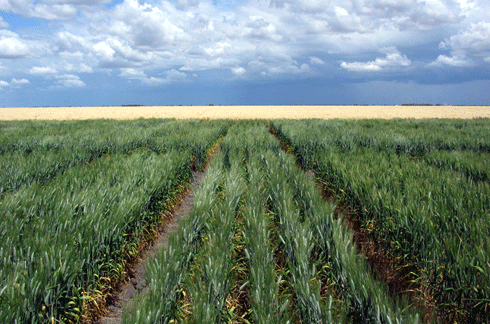
|
Published: 19 March 2012
Salt-tolerant wheat a world first
A team of Australian scientists has bred salt tolerance into a variety of durum wheat that shows a 25 per cent improvement in grain yield on salt-affected soils.

|
|
Salt-tolerant durum wheat grown in northern New South Wales as part of a field trial. Credit:
CSIRO
|
Using 'non-GM' crop breeding techniques, scientists from CSIRO Plant Industry have introduced a salt-tolerant gene into a commercial durum wheat variety, with field trials showing increased yields on saline soils.
The research, published in the journal Nature Biotechnology, is the first of its kind in the world to fully describe how the gene delivers salinity tolerance to the plants – from understanding the function of the salt-tolerant genes in the lab, to demonstrating increased grain yields in the field.
‘Salinity already affects over 20 per cent of the world's agricultural soils, and poses an increasing threat to food production due to climate change,’ says CSIRO’s Dr Rana Munns, one of the lead authors.
‘Salinity is a particular issue in the prime wheat-growing areas of Australia, the world's second-largest wheat exporter after the United States,’ says Dr Matthew Gilliham from the University of Adelaide’s Waite Research Institute.
Domestication and breeding has narrowed the gene pool of modern wheat, leaving it susceptible to environmental stress. Durum wheat, used for making such food products as pasta and couscous, is particularly susceptible to soil salinity.
Wild relatives of modern-day wheat remain a significant source of genes for a range of traits, including salinity tolerance. The researchers discovered the new salt-tolerant gene in an ancestral cousin of modern-day wheat, Triticum monococcum.
‘The salt-tolerant gene (known as TmHKT1;5-A) works by excluding sodium from the leaves. It produces a protein that removes the sodium from the cells lining the xylem, which are the “pipes” plants use to move water from their roots to their leaves,’ says Dr Gilliham.
Field trials were conducted at a variety of sites across Australia, including a commercial farm in northern New South Wales.
‘While most studies only look at performance under controlled conditions in a laboratory or greenhouse, this is the first study to confirm that the salt-tolerant gene increases yields on a farm with saline soils,’ says CSIRO’s Dr Richard James.
‘Importantly, there was no yield penalty with this gene,’ Dr James says.
‘Under standard conditions, the wheat containing the salt-tolerance gene performed the same in the field as durum that did not have the gene. But under salty conditions, it outperformed its durum wheat parent, with increased yields of up to 25 per cent.
‘This is very important for farmers, because it means they would only need to plant one type of seed in a paddock that may have some salty sections,’ Dr James says.
According to Dr Munns, new varieties of salt-tolerant durum wheat could be a commercial reality in the near future.
Because the gene was introduced into the durum wheat through ‘non-GM’ breeding processes, ‘it is not classified as transgenic and can therefore be planted without restriction’, says Dr Munns.
The researchers are taking their work a step further and have now crossed the salt-tolerance gene into bread wheat. This is currently being assessed under field conditions.
This research is a collaborative project between CSIRO, NSW Department of Primary Industries, University of Adelaide, the Australian Centre for Plant Functional Genomics and the ARC Centre of Excellence in Plant Energy Biology. It is supported by the Grains Research and Development Corporation (GRDC) and Australian Research Council (ARC).
Source: University of Adelaide



